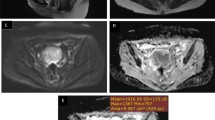Abstract
Objectives
To evaluate the potential value of apparent diffusion coefficient (ADC) measurement in the assessment of cervical cancer.
Methods
One hundred twelve patients with cervical cancer and 67 control subjects underwent diffusion-weighted imaging (DWI) in addition to routine MR imaging at 3.0-T MRI before therapy. All ADCs were calculated from b = 0, 600 s/mm2 and b = 0, 1,000 s/mm2.
Results
The ADCs of cervical cancer were significantly lower than those of normal cervix for both ADC maps. There was a statistically significant difference between the ADCs of well-/moderately differentiated (G1/2) tumours and poorly differentiated (G3) tumours, between the ADCs of squamous cell carcinoma and adenocarcinoma, between the pretherapy ADCs of tumour recurrence or metastasis and tumour free patients after radical hysterectomy for both ADC maps. There was no significant difference among the ADCs of cervical cancer when divided by other features (FIGO, lymph node status, tumour size and age groups) for both ADC maps.
Conclusion
ADC values were reliable for differentiating cervical cancer from normal cervix with high diagnostic accuracy. The ADCs can be used to indicate the degree and histological type of cervical cancer, although there is some overlap. G3 tumours and lower ADCs may indicate poor prognosis. The diagnostic accuracy was equal for both ADC maps.
Key Points
• Diffusion-weighted magnetic resonance imaging provides new information about cervical cancer
• Apparent diffusion coefficient values can differentiate cervical cancer from normal cervical tissue
• Pretherapy ADCs can also predict the prognosis for patients who have undergone radical hysterectomy
• ADCs can help indicate the degree and histological type of cervical cancer
• Patients with G3 tumours and lower ADCs may benefit from preoperative chemoradiation





Similar content being viewed by others
References
Padhani AR, Liu G, Koh DM et al (2009) Diffusion-weighted magnetic resonance imaging as a cancer biomarker: consensus and recommendations. Neoplasia 11:102–125
Wang J, Takashima S, Takayama F et al (2001) Head and neck lesions: characterization with diffusion-weighted echo-planar MR imaging. Radiology 220:621–630
Sala E, Rockall A, Rangarajan D, Kubik-Huch RA (2010) The role of dynamic contrast-enhanced and diffusion weighted magnetic resonance imaging in the female pelvis. Eur J Radiol 76:367–385
Punwani S (2011) Diffusion weighted imaging of female pelvic cancers: concepts and clinical applications. Eur J Radiol 78:21–29
Kim HS, Kim SY (2007) A prospective study on the added value of pulsed arterial spin-labeling and apparent diffusion coefficients in the grading of gliomas. Am J Neuroradiol 28:1693–1699
Higano S, Yun X, Kumabe T et al (2006) Malignant astrocytic tumours: clinical importance of apparent diffusion coefficient in prediction of grade and prognosis. Radiology 241:839–846
Zhang J, Tehrani YM, Wang L, Ishill NM, Schwartz LH, Hricak H (2008) Renal masses: characterization with diffusion-weighted MR imaging—a preliminary experience. Radiology 247:458–464
Hoogendam JP, Klerkx WM, de Kort GA et al (2010) The influence of the b-value combination on apparent diffusion coefficient based differentiation between malignant and benign tissue in cervical cancer. J Magn Reson Imaging 32:376–382
Koh DM, Takahara T, Imai Y, Collins DJ (2007) Practical aspects of assessing tumours using clinical diffusion-weighted imaging in the body. Magn Reson Med Sci 6:211–224
Charles-Edwards E, Morgan V, Attygalle AD et al (2011) Endovaginal magnetic resonance imaging of stage 1A/1B cervical cancer with A T2- and diffusion-weighted magnetic resonance technique: effect of lesion size and previous cone biopsy on tumour detectability. Gynecol Oncol 120:368–373
Payne GS, Schmidt M, Morgan VA et al (2010) Evaluation of magnetic resonance diffusion and spectroscopy measurements as predictive biomarkers in stage 1 cervical cancer. Gynecol Oncol 116:246–252
Chen J, Zhang Y, Liang B, Yang Z (2010) The utility of diffusion-weighted MR imaging in cervical cancer. Eur J Radiol 74:101–106
Liu Y, Bai R, Sun H, Liu H, Wang D (2009) Diffusion-weighted magnetic resonance imaging of uterine cervical cancer. J Comput Assist Tomogr 33:858–862
Kilickesmez O, Bayramoglu S, Inci E, Cimilli T, Kayhan A (2009) Quantitative diffusion-weighted magnetic resonance imaging of normal and diseased uterine zones. Acta Radiol 50:340–347
McVeigh PZ, Syed AM, Milosevic M, Fyles A, Haider MA (2008) Diffusion-weighted MRI in cervical cancer. Eur Radiol 18:1058–1064
Naganawa S, Sato C, Kumada H, Ishigaki T, Miura S, Takizawa O (2005) Apparent diffusion coefficient in cervical cancer of the uterus: comparison with the normal uterine cervix. Eur Radiol 15:71–78
Bilimoria KY, Bentrem DJ, Rock CE, Stewart AK, Ko CY, Halverson A (2009) Outcomes and prognostic factors for squamous-cell carcinoma of the anal canal: analysis of patients from the National Cancer Data Base. Dis Colon Rectum 52:624–631
Hong JH, Tsai CS, Wang CC et al (2000) Comparison of clinical behaviors and responses to radiation between squamous cell carcinomas and adenocarcinomas/adenosquamous carcinomas of the cervix. Chang Gung Med J 23:396–404
Heatley MK (1999) Systematic review and meta-analysis in anatomic pathology: the value of nuclear DNA content in predicting progression in low grade CIN, the significance of the histological subtype on prognosis in cervical carcinoma. Histol Histopathol 14:203–215
Acknowledgments
Fei Kuang and Jing Ren contributed equally to the manuscript.
Author information
Authors and Affiliations
Corresponding authors
Rights and permissions
About this article
Cite this article
Kuang, F., Ren, J., Zhong, Q. et al. The value of apparent diffusion coefficient in the assessment of cervical cancer. Eur Radiol 23, 1050–1058 (2013). https://doi.org/10.1007/s00330-012-2681-1
Received:
Revised:
Accepted:
Published:
Issue Date:
DOI: https://doi.org/10.1007/s00330-012-2681-1




